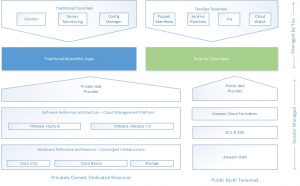No blogs for nearly five months – not great, but crikey what a busy 6 months I’ve had!
Q3 & Q4 2015 saw me join a new business, address some of the immediate ‘tactical’ issues that were challenging them and most importantly develop a new infrastructure target architecture and a plan to deliver it. So far 2016 has been about delivering against those plans.
- A new co-located data centre to host all the centralized server systems, complete with new backup and DR solutions, monitoring and an IaaS automation platform.
- A new solution to refresh networks and servers in remote sites with a simpler to manage technology architecture. This would act as a springboard for delivering new services into those locations. This project looked at securing the network using a centrally managed policy driven security solution, to help deliver secure segmentation for PCI compliance and to facilitate the consolidation of network kit (using Cisco ISE and TrustSec). It also included delivered a new server hosting platform using HCIA (hyper converged infrastructure appliances).
These work streams consisted three tender processes, 18 submissions and lots of time spent with vendors and partners to drive out the solutions. I can honestly say that I have never worked at such a breakneck pace before, but it has been absolutely liberating to be empowered to the degree I have. Compared to previous roles it feels like I’ve squeezed 2 or 3 years work into 12 months!
The first project I wanted to cover is the replacement of the internal server hosting capability with a co-lo hosted solution.
The rationale for pursuing the hybrid cloud route rather than purely public for this was in main part due to a decision to adopt a ‘crawl, walk, run’ approach to cloud consumption. We have taken a service which is in effect a managed private cloud – delivered as a single product within 30 days, which includes all the infrastructure elements to support current and future workloads, whilst implementing an IaaS automation tier that enables the agile delivery of infrastructure.
In real practical terms it is consumed just as you would a public cloud provider; either via a portal or via an API. The advantage is that in the short to medium term the organisation can take the investment in the ‘DevOps’ tooling layer (Jenkins, Puppet for example) that was initially used with AWS EC2 and leverage it against VMware vRA instances too. The organisation will have public and private IaaS providers with consumption and configuration driven by a single tooling layer that ensures consistent VM and application delivery regardless of where it gets deployed. This is great in terms of ensuring consistent deployment across application environments i.e. if dev and test are in public cloud and pre prod and production are in private. I think hybrid IaaS is probably the most accurate description of the current capability.
This new emerging model is referred to as a ‘True Private Cloud’ by WIKIBON, to describe a pre-validated, preconfigured private cloud solution, as opposed to the more traditional build your own model that is often seen as difficult, expensive and time consuming.
http://wikibon.com/true-private-cloud-will-begin-shipping-to-the-market-in-2016/
This really strikes at the heart of the question ‘where does your IT department deliver value?’. One opinion is that it is in the layer that contains the IP specific to your organization – the applications, the data, the business logic. Public cloud has commoditised infrastructure to such a degree that a managed private cloud or ‘true private cloud’, is an inevitable consequence of this shift in emphasis away from building a managing infrastructure components. Converged systems using hardware reference architectures such as vBlock were the first step on this path; they commoditised the infrastructure design to a validated blueprint or product SKU. Taking a True Private Cloud effectively delivers a software reference architecture (typically VMware vRealize) directly on top of of that hardware reference architecture and bundles it as a product, potentially with the management of it too if taken from a service provider. Adopting private / hybrid cloud has never been easier, or the time to value shorter.
The lesson learnt – private cloud doesn’t have to mean doing it all yourself, or having to manage infrastructure. True Private Cloud is a great compliment to public cloud if hybrid is your end goal.
Share this post:

